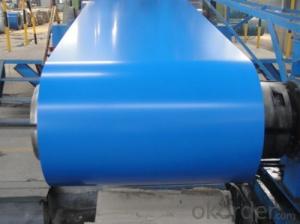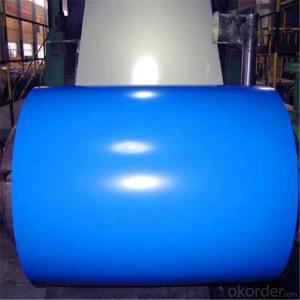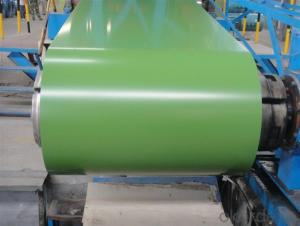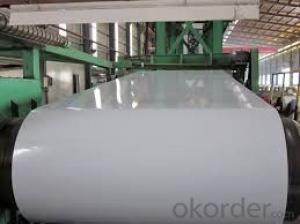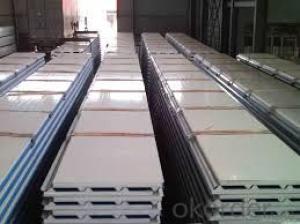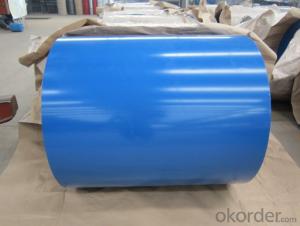High Quality of Prepainted Galvanized Steel Coil in China
- Loading Port:
- Tianjin
- Payment Terms:
- TT OR LC
- Min Order Qty:
- 50 m.t
- Supply Capability:
- 10000 m.t/month
OKorder Service Pledge
OKorder Financial Service
You Might Also Like
1. Pre-Painted Galvanized/Aluzinc Steel Coil Description:
With GI as base material, after pretreatment (degrease and chemical treatment ) and liquid dope with several layers of color, then after firing and cooling, finally the plate steel is called pre-painted galvanized (aluzinc) steel. Pre-painted galvanized steel is good capable of decoration, molding, corrosion resistance. It generally displays superior workability, durability and weather resistance.
2.Main Features of the Pre-Painted Galvanized/Aluzinc Steel Coil:
• Excellent process capability
• Smooth and flat surface
• Workability, durability
• Excellent heat resistance performance
• High strength
• Good formability
• Good visual effect
3.Pre-Painted Galvanized/Aluzinc Steel Coil Images
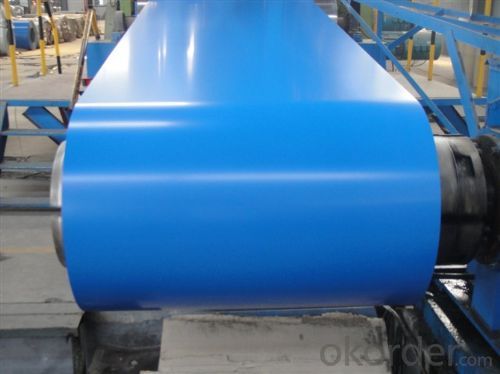
4.Pre-Painted Galvanized/Aluzinc Steel Coil Specification
Standard: AISI, ASTM, BS, DIN, GB, JIS
Grade: DX51D, DX52D
Thickness: 0.17-2.0mm
Brand Name: KMRLON
Model Number: coil
Type: Steel Coil
Technique: Cold Rolled
Surface Treatment: Coated
Application: Boiler Plate
Special Use: High-strength Steel Plate
Width: 20-1250mm
Length: customized
commoidty: pre-painted galvanized steel coil
Thickness: 0.13-4.0mm
width: 20-1250mm
zinc coating: 40-180g/m2
printing thickness: top side: 20+/-5 microns, back side: 5-7 microns
color: all RAL color
surface treatment: color coated
coil weight: 4-7 tons
coil ID: 508/610mm
packaging: standard seaworthy packing
5.FAQ of Pre-Painted Galvanized/Aluzinc Steel Coil
What’s the application of this product?
Roof, roof structure, surface sheet of balcony, frame of window, etc.
What’s the brand of the paint?
We use the best brand of all of the word—AKZO.
- Q: How does the thickness of a steel coil affect its applications?
- The applications of a steel coil are significantly affected by its thickness. The thickness of the coil is what determines its strength, durability, and versatility, thus making it suitable for various uses in different industries. In industries where strength is of utmost importance, such as construction, thicker steel coils are preferred. Thicker coils provide higher structural integrity and load-bearing capacity, which are essential in projects involving buildings, bridges, and infrastructure. Moreover, thicker steel coils offer better resistance against bending, warping, and other forms of deformation, making them ideal for heavy-duty applications. The durability of a steel coil is also influenced by its thickness. Thicker coils exhibit greater resistance to wear, corrosion, and damage, making them suitable for harsh environments or applications that involve constant friction or exposure to elements. For instance, thicker steel coils are commonly utilized in the manufacturing of heavy machinery, automotive parts, and mining equipment, where durability is of paramount importance. Furthermore, the thickness of a steel coil determines its versatility and adaptability. Thinner coils can be easily shaped into different forms and sizes, making them suitable for applications that require intricate designs or tight tolerances. Industries such as automotive, aerospace, and consumer electronics often rely on thinner steel coils due to their lightweight and flexible nature. On the other hand, the weight and reduced flexibility of thicker steel coils may limit their range of applications. They are better suited for applications that prioritize strength and durability over versatility. These applications include structural components, large-scale machinery, and industrial equipment. To summarize, the thickness of a steel coil plays a pivotal role in determining its applications. Thicker coils offer increased strength, durability, and resistance, making them ideal for heavy-duty applications in the construction and manufacturing industries. Conversely, thinner coils provide versatility and adaptability, making them suitable for applications that require intricate designs or lightweight properties.
- Q: I have good quality knives that I sharpen with various things, but mostly with a fine, diamond encrusted dry stone (eze lap) . When I run them over the steel, it doesn't seem to make any difference. I've heard that it aligns the edge, whatever that means. Using a steel, is it all just for show ?
- It does NOT sharpen a knife, It helps to keep a sharp knife sharp. Once you have sharpened your knife weather on a stone or other ways you should use the steel before using each time to keep it's edge . Think of an athlete who works out to gain muscles(sharpening) and stretches(steel) before using them. The show part is all in the way you use the steel, some just go downward and some go upward, either way you need to change sides of the blade on each stroke just like sharpening.
- Q: I mean, besides the light weight and other graces of Aluminium and Carbon, Steel frames are absolutely out-dated and they have nothing to do these days... or it is still possible to enjoy a nice ride on our heavy old pals?
- Ah, I took a nice 40mi spin on my steel road bike today. Maybe it's not as fast as my other rides...I don't know, I'm too busy enjoying the ride. Steel is timeless.
- Q: What are the challenges in coil slitting for thin gauge materials?
- Coil slitting for thin gauge materials comes with its own set of challenges that need to be addressed for a successful operation. One major challenge is the handling and stability of the thin gauge material. The thinner the material, the more prone it is to deformation, wrinkling, or even tearing during the slitting process. This requires careful attention to the handling equipment and techniques to ensure proper tension and support throughout the slitting operation. Another challenge is maintaining consistent and precise slitting widths. Thin gauge materials are often used in applications where accuracy is crucial, such as in electronic components or automotive parts. Any variation in slitting width can lead to functional defects or assembly problems. Achieving precise slitting widths in thin gauge materials requires high-quality slitting knives, well-maintained slitting machinery, and accurate tension control systems. Additionally, thin gauge materials are more susceptible to surface defects, such as scratches or burrs, during the slitting process. These defects can affect the material's appearance, performance, or even its safety. Proper selection of slitting knives and regular maintenance of the slitting machinery are essential to minimize the occurrence of surface defects. Furthermore, thin gauge materials often have a higher yield strength, meaning they are more resistant to deformation. This poses a challenge when it comes to achieving clean and straight edges during the slitting process. Special considerations need to be taken to ensure that the slitting knives are sharp and properly aligned to achieve clean cuts without introducing any edge defects. Lastly, thin gauge materials are generally more sensitive to external factors such as temperature, humidity, or static electricity. These factors can affect the material's dimensional stability, leading to variations in slitting width or other quality issues. Consequently, it is important to establish suitable environmental conditions and implement proper anti-static measures to minimize the impact of these factors. In summary, the challenges in coil slitting for thin gauge materials revolve around handling and stability, maintaining precise slitting widths, minimizing surface defects, achieving clean and straight edges, and mitigating the impact of external factors. Overcoming these challenges requires a combination of appropriate equipment, techniques, and operational controls to ensure high-quality slitting results.
- Q: Why is steel a stiff material?I'm doing a project on the use of steel in the construction of skyscrapers - and obviously, for the inner steel skeleton of a skyscraper the steel support beams and girders will have to be stiff so that they don't fall apart or the building doesn't shake due to wind or other natural forces.But in my research I've found that steel (mild steel to be more exact) is ductile and malleable, meaning it can be shaped fairly easily. However, how can steel ALSO be stiff - the definition of stiffness is the tendency to withstand bending and stretching - so my question is. How can this material be BOTH ductile/malleable, AND stiff? and why? :)Thank you in advance if anyone takes the time to answer this, would be appreciated - I'll give you 10 points straight away if the answers conclusive
- Steel is NOT stiff. In fact it is worldly accepted metals (steel is a metal) are not rigid in mechanical terms, and rigid means stiff. Steel easy to shape, but is strong and therefore hard to break. Thermosetting polymers (hard plastic) which is stiff, is in fact easy to break (weak) and also hard to reshape without changing its state (solid to liquid). Whoever told you steel is stiff is wrong and possible meant steel is strong, or you misheard/misunderstood.
- Q: When I took guitar lessons, I found that the Nylon strings are easier for me, but I love the sound of steel strings. Now, I have my own acoustic guitar, and 2 strings broke off, so I'm getting strings today. I'm not sure if Nylon strings would 'fit' on my guitar, and it's to soft of a noise. But the steel are much better sounding, but it's a little bit harder to push the string down on the fret. Which do you prefer, why?(:
- If your acoustic guitar is a steel-string (acoustic only means it's not electric) you can only put steel strings on it. Nylon strings would probably require modification of the nut and would sound terrible even then. A steel-string guitar is built and braced to work with steel strings and will not respond properly to the lighter tension of nylon strings. On the other hand, steel strings will destroy a guitar that is built for nylon in very short order. There are two things you can do here. If you have a steel-string guitar and are still using the strings that came on it, they are probably light gauge. You could try an extra-light set or even silk steel. Alternatively, you could have your guitar looked at by a guitar tech or other knowledgeable person and see if it needs a setup. The action (string height off the fretboard) on a properly adjusted steel-string guitar should actually be lower than on a classical guitar. Cheap guitars off the internet or from non-music stores are especially notorious for being poorly adjusted.
- Q: How are steel coils loaded and unloaded from ships?
- Steel coils are typically loaded and unloaded from ships using heavy-duty cranes and specialized equipment. When loading, the coils are lifted from the dockside or storage area using a crane with strong lifting capacity. They are carefully positioned onto the ship's deck, ensuring proper balance and securement to prevent any damage during transit. Unloading is done in a similar manner, with the crane carefully lifting the coils from the ship's deck and placing them onto the dock or designated storage area. Throughout the process, safety protocols are followed to ensure the smooth and efficient handling of these heavy and valuable cargo.
- Q: I completed the missions in broken steel like: the one of the rangers, the one of vault 101, the one of the enclave, and several others.are there any more INTERESTING missions?
- Um The ranger mission is not broken steel and Vault 101 isn't either. After completing Broken steel you should go to this guy called griffon in underworld and talk to him about him getting aqua pura(Or aqua cura) Then after he brings you to 2 other quests from this guy called bigsley. Thats all I could find thats interesting. You should go to a place called oasis. Its at the very top of the map, Small quest up there but really cool. Go look it up on youtube if you want. You could also go to paradise falls and kill all the slavers and save the slaves, That gets you a quest and a achievement if you free them. Also the guard at paradise has a quest for you. Also has a achievement, The quest is called strictly business, Its more of a evil karma quest though. if you don't want to be evil just take the cool weapon he gives you then kill him :P, all i can think of right now. if you have a hard time finding places for stuff, Youtube might help. or getting the explorer perk.
- Q: How do steel coils contribute to earthquake resistance in structures?
- Steel coils contribute to earthquake resistance in structures by providing strength and flexibility. When incorporated into the structural design, steel coils can absorb and dissipate the energy generated during an earthquake, reducing the impact on the building. This helps prevent the structure from collapsing or suffering major damage. Additionally, steel coils enhance the overall stability and rigidity of the building, making it more resistant to seismic forces.
- Q: Can steel coils be used in the production of furniture?
- Yes, steel coils can be used in the production of furniture. Steel coils can be used to create sturdy frames for furniture such as chairs and sofas. The coils can be shaped and welded together to provide support and durability to the furniture.
Send your message to us
High Quality of Prepainted Galvanized Steel Coil in China
- Loading Port:
- Tianjin
- Payment Terms:
- TT OR LC
- Min Order Qty:
- 50 m.t
- Supply Capability:
- 10000 m.t/month
OKorder Service Pledge
OKorder Financial Service
Similar products
Hot products
Hot Searches
Related keywords















